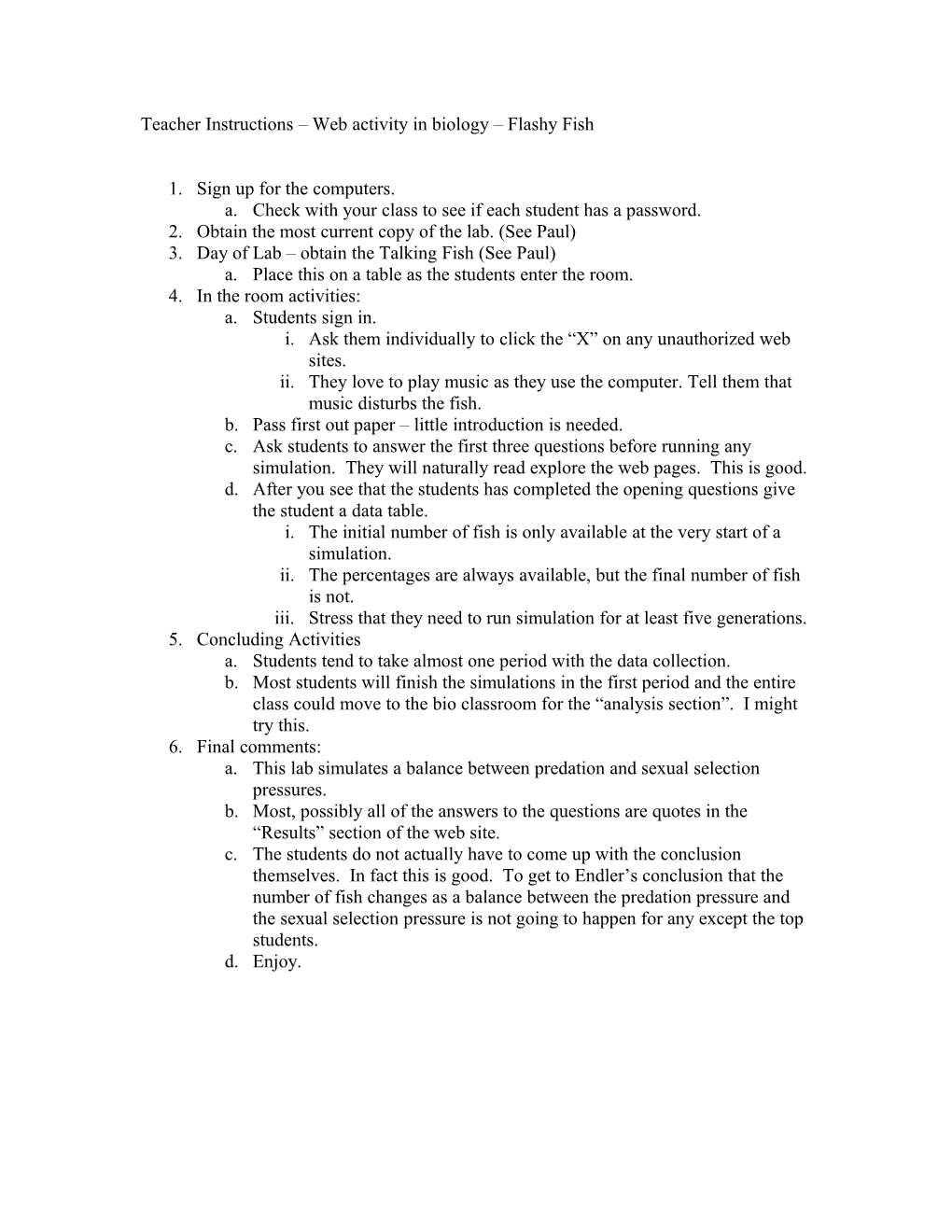Teacher Instructions – Web activity in biology – Flashy Fish
- Sign up for the computers.
- Check with your class to see if each student has a password.
- Obtain the most current copy of the lab. (See Paul)
- Day of Lab – obtain the Talking Fish (See Paul)
- Place this on a table as the students enter the room.
- In the room activities:
- Students sign in.
- Ask them individually to click the “X” on any unauthorized web sites.
- They love to play music as they use the computer. Tell them that music disturbs the fish.
- Pass first out paper – little introduction is needed.
- Ask students to answer the first three questions before running any simulation. They will naturally read explore the web pages. This is good.
- After you see that the students has completed the opening questions give the student a data table.
- The initial number of fish is only available at the very start of a simulation.
- The percentages are always available, but the final number of fish is not.
- Stress that they need to run simulation for at least five generations.
- Concluding Activities
- Students tend to take almost one period with the data collection.
- Most students will finish the simulations in the first period and the entire class could move to the bio classroom for the “analysis section”. I might try this.
- Final comments:
- This lab simulates a balance between predation and sexual selection pressures.
- Most, possibly all of the answers to the questions are quotes in the “Results” section of the web site.
- The students do not actually have to come up with the conclusion themselves. In fact this is good. To get to Endler’s conclusion that the number of fish changes as a balance between the predation pressure and the sexual selection pressure is not going to happen for any except the top students.
- Enjoy.
Name:
Date:
Period:
Flashy Fish
An On Line Lab Activity in Biology
Professor John Endler traveled to Trinidad in the 1970s to study wild guppies. The guppies live in small streams that flow down mountains from pool to pool. In this activity you will take part in an online simulation of Endler’s work. You will collect data, formulate a hypothesis, and run a series of experiments. You will find out the interplay between predation and sexual selection in the wild population of guppies.
Procedures
- Select the web site:
1a. (Optional) Open ‘Word” and type the lab.
- Launch the “Sex and the Single Guppy” Web Activity
- Select “I’m ready to find out.”
- Read the text, and click on the pools to investigate the guppy stream more closely. Answer data questions #1 and #2
- Then click on “What causes guppy color variation?” Select one of the hypotheses or create on of your own, and record it in #3 below:
- Visit the Guppy Gallery. Read about the different type of guppies, their predators, and their habitats.
- Click “simulation.” Proceed with the simulation by creating and carrying out several field experiments to test your hypothesis. Run it for at least five generations. Record the data.
- Answer the questions on the data from and be prepare to discuss your hypothesis, your experiment, and your explanation with the class.
Formulating a hypothesis:
- If being a flashy attracts predators, why are male guppies so colorful?
- What do you think is responsible for the variation in the color from one generation to the next?
- Select a hypothesis and record it here.
Conclusion and Analysis Questions:
- Why do some guppies tend to be drabber than others?
- Why are some guppies more colorful?
- What role does color play in guppy survival?
- Explain the push and pull that the environment has on the coloration of guppies in Endler’s pools.
- Is this an example of macroevolution (the creation of a new species)?
- Finally, write a statement that includes the words guppies, predation, and sexual selection that summarizes the lab and shows you understand the factors that cause the population of guppies to change.
Grading – Flashy Fish
- Did the student remain on the proper web site for the activity?
- Did the student arrive on time and work efficiently?
- Did the student work individually?
- (#1) says “females select colorful males as mates”
- (#2) says “genes are passed on to the next generation”
- (#4) says “drabber guppies escape predation”
- (#5) says “colorful guppies attract females more easily:
- (#7) says “forces of predation and sexual selection pull in opposite directions”
- Does the data table include enough trial of five generation?
- Did the student seem to enjoy this Lab on the Web?
10987654321
A+AA-B+BC+C-DDE
